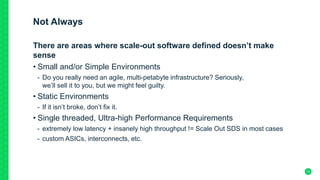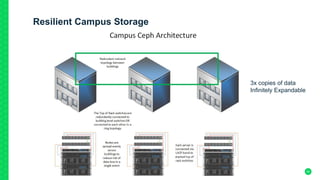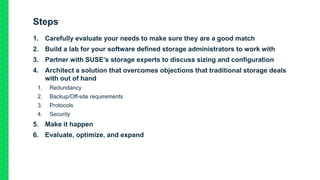start_your_datacenter_sds_v3
- 1. Transform Your Data Center From Traditional to Software Defined By Doing Storage First David Byte Sr. Technical Strategist SUSE
- 2. 2 Who is David Byte? • Sr. technical strategist on the SUSE IHV Alliances & Embedded team • Specializes in storage, HPC and ARM64 • Live in Jenks, OK – a suburb of Tulsa • 20+ year veteran in the IT industry (15+ in storage and 20+ in Linux) LinkedIn: http://LinkedIn/in/davidbyte Blog: www.suse.com/communities/blog/author/davidbyte/
- 3. Abstract 3 Lines are blurring between storage, compute and network and their administration as the move towards software-defined data centers gain momentum. In this session, we will discuss how to integrate Ceph via SUSE Enterprise Storage into today’s data center environment while enabling the migration to a software- defined data center of the future..
- 5. Software-defined Storage Software-defined storage delivers the full suite of storage services via a software stack that runs on commodity hardware
- 6. Some Analyst Terms Mode 1 – Gartner for Traditional Legacy Data center • Network, compute, and storage silos • Fibre Channel, iSCSI, CIFS, NFS Process Driven • Slow to respond This is what customers have today Mode 2 – Gartner for Software Defined Software-defined Data Center • Software-defined everything Agile infrastructure • Supports a DevOps model • Business driven This is where customers want to go Bi-Modal
- 8. Business Has a Continuing Storage Challenge Storage Doubles Every 18 Months IT Budgets Are Flat Storage costs decline 25% annually 0 5,000 10,000 15,000 20,000 25,000 30,000 35,000 40,000 2009 2010 2011 2012 2013 2014 2015 2016 2017 2018 2019 2020 But data grows 40% annually We are here
- 10. The answer to all challenges is 10 THE CLOUD?
- 11. Do you understand the expense? Do you really want S3 or do you really want object storage? • If S3, why? - Offsite - Not maintained in-house - Perceived lower cost • If Object, is off-site at a cloud provider really a requirement? Everyone Thinks They Want to Use AWS S3
- 12. • At first, it seems like a great idea. Cloud is cheap, you don’t really have to do capacity planning. • Well, it’s cheap until you need to access all that data. You started with 500TB, but now it’s more than 20PB and costing you more than $500,000 per month. • You want to talk about vendor lock-in? What’s the cost to transfer it out of the cloud? The Cost of Public Cloud
- 13. Okay, surely the answer is 13 SDS!
- 14. Not Always 14 There are areas where scale-out software defined doesn’t make sense • Small and/or Simple Environments - Do you really need an agile, multi-petabyte infrastructure? Seriously, we’ll sell it to you, but we might feel guilty. • Static Environments - If it isn’t broke, don’t fix it. • Single threaded, Ultra-high Performance Requirements - extremely low latency + insanely high throughput != Scale Out SDS in most cases - custom ASICs, interconnects, etc.
- 15. So, What Do I Do? 15
- 16. Go SDx, Storage First While storage is one of the most critical parts of the data center, it also has well defined interfaces and operating parameters • Carefully weigh requirements, skill sets, and potential for data growth • Match up your requirements with the proper technology • Implement based on how you work today with the infrastructure in place to transform with the business • Understand data protection and availability requirements 16
- 17. Enable Transformation Mode 1 – Gartner for Traditional Legacy Data Center • Network, compute, and storage silos • Fibre Channel, iSCSI, CIFS, NFS Process Driven • Slow to respond This is what customers have today Mode 2 – Gartner for Software Defined Software-defined Data Center • Software-defined everything Agile infrastructure • Supporting a DevOps model • Business-driven This is where customers want to go Support today’s investment Adapt to the future
- 19. Three Questions Do you have storage needs that are growing faster than your budget? Is the data “Large” and in large quantities? Is there a partner I can trust?
- 20. 20 Why SUSE? SUSE is a storage expert • Software defined storage with out HA stack for a very long time • DRBD IS SDS • Multiple file systems brought to market, both normal and cluster file systems • ReiserFS, XFS, OCFS2, BTRFS, etc SUSE is building out reference architectures and designs • Both hardware and software partners • Solution oriented process
- 21. SUSE Enterprise Storage powered by Ceph • A highly scalable and resilient software- based storage solution. • Enables organizations of any size to build cost-efficient, highly scalable storage. • Utilizes off-the-shelf servers and disk drives. • Self-managing and delivers storage functionality comparable to mid / high-end storage products at a fraction of the cost. 21
- 22. Understand the technology - Open Source Ceph Code Developers 906 Core Regular Casual 28 63 813 Total downloads 305,973,578 Unique downloads 37,422,434 Client Servers (Windows, Linux, Unix) RADOS (Common Object Store) Block Devices Server Object Storage File Interface Storage Server Storage Server Storage Server Storage Server Server Server Storage Server Storage Server Applications File Share OSD OSD OSD OSD OSD OSD NetworkCluster MON RBD iSCSI S3 SWIFT CephFS* Monitors MONMON
- 23. 23 Understanding Where Scale-Out SDS Is Good
- 24. What is Large Data? 24 For comparison, while “big data” is a significant number of individual data that is of “normal” size, I’m defining “large data” as an individual piece of data that is massive in its size. Large data, generally, is not required to have real-time or fast access, and is often unstructured in its form (ie. doesn’t conform to the parameters of relational databases). - Joseph George, VP, Solutions at SUSE
- 25. Large Data – Science and Media Scientific Organizations • Meteorological data • Telescope recordings • Satellite feeds Media Industries • TV stations • Radio stations • Motion picture distributors • Web music/video content 25
- 26. Large Data - Video • Facility security surveillance • Red light/traffic cameras • License plate readers • Body cameras for law enforcement • Military/government visual reconnaissance 26
- 27. Object or Block Bulk Storage Data that constantly grows during the course of business • D2D Backup • HPE Data Protector and others • Financial records • Medical Data • Genomics • PACs Data
- 28. Virtual Machine (VM) Storage • Ceph is already the leading storage choice for OpenStack environments • Low and mid i/o virtual machine storage for major hypervisor platforms • kvm – native RBD • Hyper-V – iSCSI • VMware - iSCSI 28
- 30. Resilient Campus Storage 30 3x copies of data Infinitely Expandable
- 31. Reference Architectures & Designs https://www.suse.com/products/suse-enterprise-storage/ Under the Resources Link More information under the White Papers Link
- 33. Steps 1. Carefully evaluate your needs to make sure they are a good match 2. Build a lab for your software defined storage administrators to work with 3. Partner with SUSE’s storage experts to discuss sizing and configuration 4. Architect a solution that overcomes objections that traditional storage deals with out of hand 1. Redundancy 2. Backup/Off-site requirements 3. Protocols 4. Security 5. Make it happen 6. Evaluate, optimize, and expand
- 34. Thanks For Coming! SUSE offers an enterprise ready, bi-modal solution for today’s environment that answers tomorrow’s needs. For more information, please visit: www.SUSE.com

































